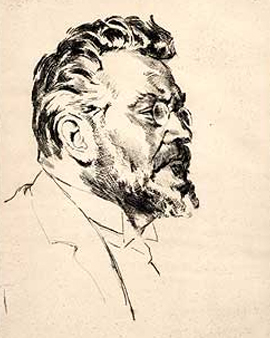


Max Slevogt's artistic talent was discovered at the age of four. Today, the artist is known as an important painter of impressionism. Besides his work as a painter, he was a successful graphic artist and illustrator. He also worked as a stage designer at various theatres. First Max Slevogt studied at the Academy of Arts in Munich, where he created his first landscape paintings. He broke away from the academic tradition of painting and sought new ways of expressing himself. From 1890 onwards his paintings were no longer created in the studio. Unlike other artists, Slevogt now painted in the open air. Slevogt loved the depiction of glaring light that enveloped his landscapes, figures and objects. Max Slevogt painted not only panel paintings, stage sets and murals. In the course of his life he also made countless watercolours and drawings. He also engaged in printmaking and created illustrations for books. Max Slevogt often travelled to Italy and Egypt, which inspired his works. In 1892 he founded the Association of the XXIV Munich Secession with other artists. This association of artists was directed against the traditional academic understanding of art of the time.
German Impressionism differs from its French model in its milder colouring. The pictures are drawn more precisely. Unlike in France, the sky was not only depicted cloudless and sunny. Slevogt visited a large Rembrandt exhibition in Amsterdam in 1898, which deeply impressed him. The painter became friends with well-known artists of the theatre world. He loved music and played the piano excellently. Max Slevogt acquired a residence in 1914, which became known as the Slevogthof. From there he had a wide view over the Rhine plain. The landscape of the Palatinate had a lasting influence on his impressionistic painting style. The artist's estate was enlarged by several alterations. Slevogt set up a music hall and a library. He painted ceilings and walls with depictions from the works of popular poets and composers.
The peak of German Impressionism was at the turn of the century and ended with the beginning of the First World War. Max Slevogt was sent to the Western Front during the First World War. His war experiences there deeply disturbed him. In order to come to terms with the horror, Max Slevogt sought new forms of artistic expression. In 1917, he came to Berlin and headed a master studio at the Academy of Arts in Berlin. In Berlin he designed stage sets and illustrated books. Influenced by the traumatic war experiences, the painting styles of many European artists changed after the World War. New directions, such as Expressionism and New Objectivity, dominated the art world. Max Slevogt died in 1932. Although the upper middle classes accepted Impressionism from the 1920s onwards, the painting style came to an end in Germany in the 1930s.

Max Slevogt's artistic talent was discovered at the age of four. Today, the artist is known as an important painter of impressionism. Besides his work as a painter, he was a successful graphic artist and illustrator. He also worked as a stage designer at various theatres. First Max Slevogt studied at the Academy of Arts in Munich, where he created his first landscape paintings. He broke away from the academic tradition of painting and sought new ways of expressing himself. From 1890 onwards his paintings were no longer created in the studio. Unlike other artists, Slevogt now painted in the open air. Slevogt loved the depiction of glaring light that enveloped his landscapes, figures and objects. Max Slevogt painted not only panel paintings, stage sets and murals. In the course of his life he also made countless watercolours and drawings. He also engaged in printmaking and created illustrations for books. Max Slevogt often travelled to Italy and Egypt, which inspired his works. In 1892 he founded the Association of the XXIV Munich Secession with other artists. This association of artists was directed against the traditional academic understanding of art of the time.
German Impressionism differs from its French model in its milder colouring. The pictures are drawn more precisely. Unlike in France, the sky was not only depicted cloudless and sunny. Slevogt visited a large Rembrandt exhibition in Amsterdam in 1898, which deeply impressed him. The painter became friends with well-known artists of the theatre world. He loved music and played the piano excellently. Max Slevogt acquired a residence in 1914, which became known as the Slevogthof. From there he had a wide view over the Rhine plain. The landscape of the Palatinate had a lasting influence on his impressionistic painting style. The artist's estate was enlarged by several alterations. Slevogt set up a music hall and a library. He painted ceilings and walls with depictions from the works of popular poets and composers.
The peak of German Impressionism was at the turn of the century and ended with the beginning of the First World War. Max Slevogt was sent to the Western Front during the First World War. His war experiences there deeply disturbed him. In order to come to terms with the horror, Max Slevogt sought new forms of artistic expression. In 1917, he came to Berlin and headed a master studio at the Academy of Arts in Berlin. In Berlin he designed stage sets and illustrated books. Influenced by the traumatic war experiences, the painting styles of many European artists changed after the World War. New directions, such as Expressionism and New Objectivity, dominated the art world. Max Slevogt died in 1932. Although the upper middle classes accepted Impressionism from the 1920s onwards, the painting style came to an end in Germany in the 1930s.
Page 1 / 2






